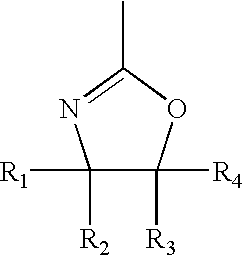Method for Forming Multilayer Coating Film
a coating film and multi-layer technology, applied in the direction of coatings, transportation and packaging, chemical instruments and processes, etc., can solve the problems of reducing the smoothness or distinctness of the image of the resulting coating film, reducing the chipping resistance or water resistance,
- Summary
- Abstract
- Description
- Claims
- Application Information
AI Technical Summary
Benefits of technology
Problems solved by technology
Method used
Image
Examples
production example 1
[0117]A reactor equipped with a thermometer, thermostat, stirrer, reflux condenser and water separator was charged with 174 parts of trimethylolpropane (molecular weight 134), 327 parts of neopentyl glycol (molecular weight 104), 352 parts of adipic acid (molecular weight 146), 109 parts of isophthalic acid (molecular weight 166) and 101 parts of hexahydrophthalic anhydride (molecular weight 154), and the temperature therein was raised from 160° C. to 230° C. over 3 hours. While distilling the formed water of condensation off with the water separator, the reaction was continued at 230° C. until the acid value of the reaction product became not higher than 3 mgKOH / g. To this reaction product, 59 parts of trimellitic anhydride (molecular weight 192) was added, and the addition reaction was carried out at 170° C. for 30 minutes, followed by neutralization by addition of 2-(dimethylamino)ethanol of equivalent amount to the acid group. Then deionized water was gradually added to effect t...
production examples 2-14
[0119]Compositions as indicated in the following Table 1 were treated similarly to Production Example 1 to provide polyester resin solutions (X-2)−(X-14) all having a solid content of 45% and pH 7.2. The combined concentration of benzene ring and cyclohexane ring, acid value, hydroxyl value, number-average molecular weight and glass transition temperature of each of the resulting polyester resins are shown in Table 1, concurrently with those of the polyester resin solution (X-1) as obtained in Production Example 1.
TABLE 1Production Example1234567Polyester resin solutionX-1X-2X-3X-4X-5X-6X-7Trimethylolpropane174174173176178280(molecular weight, 134)Neopentyl glycol327328326332319233480(molecular weight, 104)Adipic acid352354351448286343367(molecular weight, 146)Isophthalic acid10921959202106114(molecular weight, 166)Hexahydrophthalic101202558099106anhydride(molecular weight, 154)Trimellitic anhydride59595960585861(molecular weight, 192)HILAC HK-901 (note 1)(molecular weight, 878)Comb...
production example 15
[0120]A reactor equipped with a thermometer, thermostat, stirrer, reflux condenser and water separator was charged with 109 parts of trimethylolpropane, 141 parts of 1,6-hexanediol, 126 parts of hexahydrophthalic anhydride and 120 parts of adipic acid, which were heated from 160° C. to 230° C. over three hours and subjected to condensation reaction at 230° C. for 4 hours. Then further 38.3 parts of trimellitic anhydride was added to add carboxyl groups to the resulting condensation reaction product, reacted at 170° C. for 30 minutes and diluted with 2-ethyl-1-hexanol, to provide polyester resin solution (PE) having a solid content of 70%. Thus obtained polyester resin had an acid value of 46 mgKOH / g, hydroxyl value of 150 mgKOH / g, and weight-average molecular weight of 6,400.
Production of Acrylic Emulsion
PUM
| Property | Measurement | Unit |
|---|---|---|
| Temperature | aaaaa | aaaaa |
| Temperature | aaaaa | aaaaa |
| Percent by mass | aaaaa | aaaaa |
Abstract
Description
Claims
Application Information
 Login to View More
Login to View More - R&D
- Intellectual Property
- Life Sciences
- Materials
- Tech Scout
- Unparalleled Data Quality
- Higher Quality Content
- 60% Fewer Hallucinations
Browse by: Latest US Patents, China's latest patents, Technical Efficacy Thesaurus, Application Domain, Technology Topic, Popular Technical Reports.
© 2025 PatSnap. All rights reserved.Legal|Privacy policy|Modern Slavery Act Transparency Statement|Sitemap|About US| Contact US: help@patsnap.com

